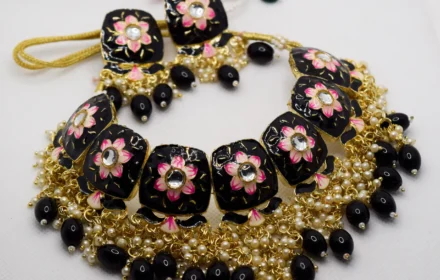Over time, your once-shiny jewelry might begin to lose its luster, turning black, dark gray, or even greenish-brown. This is a natural result of oxidation—a chemical reaction between metal surfaces and elements like oxygen, sulfur, moisture, and skin oils.
While some people love the antique, oxidized look (especially in bohemian or tribal pieces), others prefer their jewelry to remain bright, polished, and new-looking. If you’re in the latter group and wondering how to restore or clean Oxidized Jewelry’s sparkle without damaging it, you’re in the right place.
In this detailed guide, we’ll explore safe, effective, and affordable DIY methods using everyday household items like baking soda, dish soap, and alumi num foil. We’ll also share important care tips to prevent further tarnishing and protect your cherished pieces for years to come.
What Causes Oxidized Jewelry to Turn Black?
Oxidation is a surface-level chemical change that occurs when metal comes into contact with elements like:
- Oxygen or Sulfur in the air
- Moisture or humidity
- Body sweat, lotions, perfumes, or household chemicals
- Long-term storage in non-airtight containers
This process is most common in silver, brass, and copper, but even gold-plated or costume jewelry can tarnish over time.
DIY Methods to Clean Oxidized Jewelry at Home
Here are four proven home remedies to clean tarnished jewelry safely. Be sure to read the tips and precautions at the end of each method to protect delicate stones or vintage items.
1. Baking Soda and Water Paste
Best For: Lightly oxidized silver, brass, or non-gemstone jewelry.
This method uses baking soda’s natural abrasiveness to lift tarnish gently without harsh chemicals.
What You Need:
- Baking soda
- Water
- Soft toothbrush or microfiber cloth
Steps:
- Mix equal parts baking soda and water in a bowl to form a smooth paste.
- Apply the paste directly to the oxidized areas of the jewelry.
- Using a soft toothbrush or cloth, gently scrub the surface in circular motions.
- Rinse thoroughly under lukewarm water.
- Pat dry with a microfiber or cotton cloth.
Pro Tip: Do not use this method on plated jewelry or pieces with delicate stones—it could scratch the surface.
2. Mild Soap and Warm Water Soak
Best For: Delicate, gemstone-studded, or gold-plated jewelry.
This gentle method is safe for almost all types of jewelry and is particularly useful for pieces with fragile settings or intricate detailing.
What You Need:
- Few drops of mild dishwashing soap
- Warm water (not hot)
- Soft toothbrush
- Microfiber cloth
Steps:
- Mix a few drops of mild dish soap into a bowl of warm water.
- Soak the oxidized jewelry for 5–10 minutes.
- Gently scrub with a soft toothbrush, especially around prongs and corners.
- Rinse thoroughly under clean, lukewarm water.
- Pat dry with a lint-free cloth.
Pro Tip: Avoid soaking porous stones like pearls, turquoise, or opals for long periods.
3. Baking Soda, Hot Water & Aluminum Foil Bath
Best For: Heavily oxidized sterling silver jewelry.
This method leverages a chemical reaction (ion exchange) that removes tarnish without abrasion.
What You Need:
- Baking soda (2 tablespoons)
- Aluminum foil
- Hot (not boiling) water
- Dishwasher detergent (1 teaspoon)
- Glass or ceramic bowl
Steps:
- Line the bottom of your bowl with shiny side up aluminum foil.
- Place your tarnished jewelry directly on the foil.
- Sprinkle 2 tablespoons of baking soda and 1 teaspoon of dishwasher detergent over the oxidized jewelry.
- Pour hot water into the bowl until jewelry is fully submerged.
- Let sit for 30–40 minutes.
- Remove and gently rub with a soft cloth. Rinse and dry thoroughly.
Why It Works: The aluminum acts as a catalyst, helping transfer sulfur tarnish from the silver onto the foil.
Pro Tip: Avoid using this method on oxidized jewelry with glued settings or delicate stones.
4. Toothpaste Cleaning Method (for Silver Only)
Best For: Solid silver pieces with moderate tarnish.
What You Need:
- White, non-gel toothpaste (no whitening agents or microbeads)
- Soft cloth or toothbrush
Steps:
- Apply a pea-sized amount of toothpaste to a soft cloth or toothbrush.
- Gently rub the silver for 3–5 minutes.
- Rinse under lukewarm water and dry completely.
Pro Tip: Only use this method for solid silver. Toothpaste can be too abrasive for soft or plated metals.
Important Considerations Before Cleaning Oxidized Jewelry
Before you start cleaning any oxidized jewelry, keep these crucial guidelines in mind:
1. Always Test First
Apply your chosen cleaning method to a hidden or less visible area of the oxidized jewelry. This ensures the metal or any stone isn’t damaged or discolored.
2. Gentle Tools Only
Avoid abrasive brushes, paper towels, or scrubbing pads. Always use soft-bristle toothbrushes, microfiber cloths, or cotton swabs.
3. Thorough Drying is Key
After cleaning, dry your oxidized jewelry completely to prevent water stains or further tarnish. Use a soft, lint-free towel or air dry in a clean place.
4. Be Cautious with Gemstones
Stones like opals, pearls, amber, turquoise, and coral are porous and can be damaged by soaking or harsh chemicals. For such pieces, stick to the soap and water method or consult a jeweler.
How to Prevent Oxidation in the Future
Once your oxidized jewelry is clean, you’ll want to keep it that way! Here’s how to reduce oxidation and extend the life of your pieces:
- Store in zip-lock bags or airtight containers with anti-tarnish strips.
- Keep away from humidity, perfumes, lotions, and direct sunlight.
- Wear jewelry last when getting ready, after makeup, perfume, and hairspray.
- Add silica gel packets to your jewelry box to absorb moisture.
- Wipe jewelry clean after each wear to remove body oils and sweat.
Final Thoughts
Oxidized or tarnished jewelry may look worn out, but it’s rarely beyond repair. With the right tools and a little patience, you can safely restore your pieces to their former glory right at home. Whether you opt for a simple baking soda paste or the aluminum foil trick, make sure to use gentle methods and proper aftercare.
For heirloom or highly valuable items, it’s always best to consult a professional jeweler, but for most day-to-day pieces, these DIY methods are safe, easy, and effective.
FAQs: Cleaning Oxidized Jewelry at Home
Q1: What does it mean for jewelry to be “oxidized” or “tarnished”? A1: Oxidation (or tarnishing) is a natural chemical reaction that causes your jewelry to lose its shine and turn black, dark gray, or even greenish-brown. This happens when the metal surfaces interact with elements like oxygen, sulfur, moisture, and skin oils over time.
Q2: What common elements cause jewelry to oxidize? A2: Jewelry typically oxidizes due to contact with oxygen or sulfur in the air, moisture/humidity, body sweat, lotions, perfumes, household chemicals, and long-term storage in non-airtight containers.
Q3: Which types of metals are most prone to oxidation? A3: Oxidation is most common in silver, brass, and copper. However, even gold-plated or costume jewelry can tarnish over time.
Q4: Can I safely clean oxidized jewelry at home? A4: Yes, the guide provides several safe, effective, and affordable DIY methods using everyday household items like baking soda, mild dish soap, aluminum foil, and even toothpaste.
Q5: What are the main DIY methods for cleaning oxidized jewelry at home? A5: The guide outlines four primary methods:
- Baking Soda and Water Paste
- Mild Soap and Warm Water Soak
- Baking Soda, Hot Water & Aluminum Foil Bath
- Toothpaste Cleaning Method (for Silver Only)
Q6: Which cleaning method is best for delicate jewelry or pieces with gemstones? A6: The Mild Soap and Warm Water Soak is recommended as the gentlest method, safe for almost all types of jewelry, including delicate, gemstone-studded, or gold-plated pieces. However, avoid soaking porous stones (like pearls, turquoise, opals) for long periods.
Q7: How do I use the baking soda and water paste method? A7: Mix equal parts baking soda and water to form a smooth paste. Apply it to the oxidized areas, gently scrub with a soft toothbrush or microfiber cloth, then rinse thoroughly under lukewarm water and pat dry. This method is best for lightly oxidized silver, brass, or non-gemstone jewelry.
Q8: What is the aluminum foil bath method, and when should I use it? A8: This method leverages a chemical reaction for heavily oxidized sterling silver. Line a bowl with aluminum foil (shiny side up), place jewelry on it, sprinkle with 2 tablespoons baking soda and 1 teaspoon dishwasher detergent, then cover with hot (not boiling) water. Let it sit for 30-40 minutes, then remove, rub gently, rinse, and dry. It’s not recommended for jewelry with glued settings or delicate stones.
Q9: Can I use any toothpaste to clean silver jewelry? A9: No. Only use white, non-gel toothpaste that does not contain whitening agents or microbeads. This method is specifically for solid silver pieces with moderate tarnish and should not be used on plated or soft metals as it can be too abrasive.
Q10: What crucial steps should I take before cleaning any oxidized jewelry? A10: Always test your chosen cleaning method on a hidden or less visible area first. Use only gentle tools like soft-bristle toothbrushes or microfiber cloths, and ensure you thoroughly dry your jewelry after cleaning to prevent water stains or further tarnish.
Q11: How can I prevent my oxidized jewelry from oxidizing in the future? A11: To prevent future oxidation:
- Store jewelry in zip-lock bags or airtight containers, ideally with anti-tarnish strips.
- Keep pieces away from humidity, perfumes, lotions, and direct sunlight.
- Put on jewelry last when getting ready (after applying makeup, perfume, and hairspray).
- Add silica gel packets to your jewelry box to absorb moisture.
- Wipe jewelry clean after each wear to remove body oils and sweat.
Q12: When should I consider taking my oxidized jewelry to a professional jeweler? A12: For heirloom pieces, highly valuable items, or if you are unsure about a specific piece’s material or stone fragility, it’s always best to consult a professional jeweler.









Comments are closed.